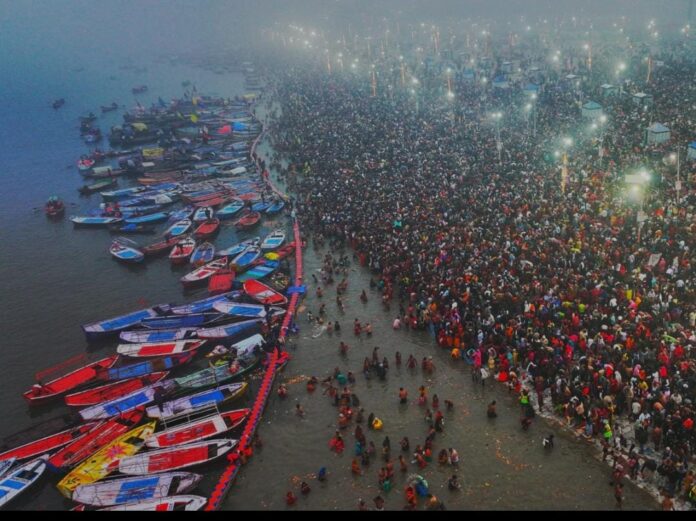
Manoj Kumar Pathak
The recent crackdown on social media misinformation regarding the Kumbh Mela reflects the government’s increasing efforts to combat the spread of false narratives, which have the potential to create panic and disrupt public harmony. While the Uttar Pradesh Police’s swift action in taking legal measures against 54 social media accounts is commendable, the broader implications of such measures raise critical questions about media ethics, freedom of speech, and the effectiveness of government strategies in tackling misinformation.
Misinformation on social media is not a new phenomenon. However, its consequences can be far-reaching, especially when it involves an event as significant as the Kumbh Mela. The recent case of a manipulated video falsely claiming a massive fire at the Mahakumbh bus stand—when, in reality, it was a 2020 oil pipeline accident in Egypt—demonstrates how quickly misinformation spreads. Similarly, the misleading claim that nationalist groups had thrown slippers at army personnel during the event was based on footage from a chaotic film production scene in Patna, Bihar. These incidents indicate the pressing need for stringent monitoring mechanisms to prevent the public from being misled.
The Uttar Pradesh government, under the leadership of Chief Minister Yogi Adityanath, has adopted a no-tolerance policy toward social media misinformation, particularly when it concerns significant religious and cultural events. The deployment of a dedicated cyber-patrolling team to monitor social media platforms around the clock marks a proactive step in ensuring that misleading narratives do not go unchecked. FIRs have been registered against seven accounts for the false fire claim and 15 accounts for the misleading army incident, highlighting the seriousness of the administration’s approach. However, this aggressive stance has also sparked debate over the potential risks of stifling dissent and restricting free speech under the guise of fighting misinformation.
Experts argue that the effectiveness of such crackdowns depends on the larger ecosystem of information dissemination. Dr. Rajesh Sharma, a media ethics scholar, warns against a blanket approach to curbing misinformation. He emphasizes the importance of distinguishing between malicious actors and individuals who unknowingly share misleading content. “While government intervention is necessary to maintain order, it should not come at the cost of suppressing critical voices. A nuanced approach that includes public education and media literacy is essential to prevent misinformation at its root,” he states. His concern reflects a growing discourse on whether the government’s stringent actions could set a precedent for curbing legitimate dissent.
The Kumbh Mela, as one of the world’s largest religious gatherings, has historically faced challenges in terms of crowd management, security, and public perception. Past incidents, such as the tragic stampedes of 2007 and 2013, which resulted in significant casualties, serve as stark reminders of the logistical hurdles in managing an event of such scale. In this context, misinformation can exacerbate existing challenges, creating unnecessary panic and undermining the government’s efforts. However, the challenge lies in tackling misinformation without creating an atmosphere of fear and suppression, where citizens hesitate to voice concerns due to the risk of legal repercussions.
The role of social media platforms in perpetuating misinformation is another critical factor that warrants attention. With millions of users engaging in real-time content sharing, the ability to verify and control the authenticity of information becomes increasingly complex. Tech giants such as Meta, Twitter, and YouTube have introduced fact-checking initiatives and misinformation detection mechanisms. However, these measures often fall short due to algorithmic biases and the sheer volume of content being uploaded every second. The government’s crackdown on specific accounts raises the question of whether social media companies should bear greater responsibility in filtering misleading content before it reaches the public domain.
At the heart of the issue is the delicate balance between maintaining order and preserving democratic values. While the government’s move to hold individuals accountable for spreading misinformation is a step toward safeguarding public trust, it also raises concerns about selective enforcement. Critics argue that the government must ensure that its actions do not disproportionately target specific groups or suppress legitimate political discourse. Transparency in how social media accounts are flagged and legal actions are initiated is crucial to maintaining credibility in such interventions.
Moreover, the effectiveness of legal crackdowns on misinformation remains debatable. Studies have shown that punitive actions alone do not deter misinformation; instead, they often drive it underground, where it festers in encrypted networks and private groups. A more sustainable approach would involve comprehensive media literacy campaigns that educate citizens about verifying information before sharing it. Integrating fact-checking initiatives within digital education curricula and collaborating with independent watchdog organizations could serve as long-term solutions to this issue.
The use of technology in combating misinformation presents both opportunities and challenges. Artificial intelligence (AI) and machine learning models are increasingly being deployed to detect and flag misleading content in real time. However, these technologies are not foolproof and often require human oversight to ensure accuracy. The government must invest in AI-driven tools while also fostering collaborations with research institutions and media watchdogs to develop a multi-pronged strategy against misinformation.
Furthermore, an alternative approach could involve creating a centralized, government-backed platform for real-time fact-checking. By disseminating verified updates on significant events, such a platform could serve as a counterbalance to misleading social media narratives. However, this initiative would need to be managed independently to avoid concerns of government propaganda influencing the credibility of fact-checking mechanisms.
International examples provide valuable insights into how misinformation can be tackled effectively. Countries like Germany have implemented stringent digital regulations, holding social media companies accountable for failing to remove harmful content. The European Union’s Digital Services Act also outlines clear guidelines for platforms to ensure transparency in content moderation. India could take cues from these models while tailoring solutions to its unique socio-political landscape.
The Uttar Pradesh government’s crackdown on misinformation surrounding the Kumbh Mela underscores the growing challenge of managing digital narratives in an era dominated by social media. While legal actions against those responsible for spreading false information are necessary, they must be part of a broader, transparent strategy that upholds democratic values. A combination of technological solutions, public education, independent fact-checking mechanisms, and regulatory accountability is required to address the misinformation crisis effectively. Without these measures, the risk of state overreach looms large, potentially undermining the very democratic principles that the government seeks to protect.


